Rana Al Ogayyel
Soft Dividers and Printed Opacity for the Construction of Muslim Women’s Self-Identity: The Al Sadu Tent Divider, the Veil and the Materiality of Privacy
Summary
I am a Saudi female artist who wears the veil in and outside Muslim countries. Soft Dividers is a project in which I explore aspects of privacy and veiled Muslim women's identities through a critical material investigation. I question degrees of occultation or shielding between the religious and the secular to show how veiling and portable dividers aid the formation of the self amongst Muslim women, enabling them to move effortlessly across cultures. Exposed to a female world more revealing in London, I create artwork that manipulates forms of veiling drawing on Bedouin tent dividers, aspects of modest clothing function as thresholds between private and public for the shrouded Muslim woman. The artwork facilitates a conversation with my project participants – Muslim women – around privacy and exchanges we made of imagery, in which roles of observer and observed are exchanged. My constructed Soft Dividers provide the parameters for this dialogue. The artwork creates portable spaces when we meet, for example, and when it is sent to and received by the women. I endeavour to articulate what is unspoken amongst other veiled women as their different habits might raise questions I had never formulated around the veil. I seek to understand that I am not alone in my desire to make the veil my portable privacy marker: it is an extension of my freedom and in no circumstances is it ever a prison. Instead, the veil extends my private mobile space, it is a continuation of the most private of private spaces in Muslim culture, the inner sanctum of the home. The veil – soft and fluid – offers a portable zone of privacy as I navigate so many of these shifting East–West / public–private spaces.
Working together with a group of shrouded Muslim women based in London and by applying Participatory Action Research (PAR), my practice draws on cloth used as marker: the Al Sadu tent divider, the veil and the changing room curtain. Al Sadu is a traditional form of woven textile, consisting of portable soft furnishings created mainly by women. It represents a deep-rooted Bedouin craft practice and is used in traditional interiors to separate private and public zones, and male and female zones. The veil as part of modest clothing prescribed by Islam forms part of the identity of shrouded Muslim woman. The changing room curtain is a ubiquitous cloth marker used around the world: it is a manifestation of anonymous privacy without symbolic or religious connotation and offers illusory privacy. The tent divider is portable, the veil metaphorical and fluid, while the changing room curtain is both a fixture and a form of non-secular, temporal shielding. I chose these cloth markers because all three – Al Sadu, the veil and changing room curtains – pose a complex relationship between symbolic and physical that reflects the multi-layered Arab Muslim sense of privacy. Therefore, I anchor my thinking between three parameters: that the experience of privacy is gendered, culturally and geographically located, as well as temporal. In constructing the artwork Soft Dividers, I am driven to explore visibility, separation, privacy and subjectivity. I look at spatiality, textiles and clothing as forms of privacy; sinuous or stable, for the human body to negotiate public space.
Additional info
Soft Dividers is a qualitative study investigated through a mixed methodology of lived experiences and active participatory research. I test assumptions and proposed outcomes guided by the collective knowledge and responses of a group of veiled Muslim women living in London and Riyadh. Working directly with these women in conjunction with my studio practice leads to collaborative thinking echoing Sennett's 'thinking through making' through PAR. Underpinning my practice-based exploration, theories of ‘soft logic’ developed by Barnett and Deleuze support how I work with the haptic. Soft logic mimics the fluid folds of cloth shaping my way of thinking to non-exclusion, negation and adjustment. Because a binary approach would be insufficient, a feminist research method drawn from Meskimmon in Practice as Thinking: towards Feminist Aesthetics, which integrates the sensual and the theoretical, seems more appropriate to the female lived experience, of mine and others. The fluidity of this approach has a bearing on my practice. Shifting places and time spent in different environments influence the practice and the experience of veiling in a sequence movement.
My journeys between Riyadh and London play a pivotal role in my research. To some degree, uprooting myself back and forth, I became a stranger to myself and, somewhat freed from cultural constraints, I have been able to reflect on my own lived experience. Therefore, as a methodology, I use ‘lived and living experience’ to anchor my research in the politics of location: through my movements between public and private spaces I document, beneath the surface the roots of religious practice and culturally different practices, even within a globalised context.
Soft Dividers begins with my experience as a Muslim woman who wears the veil: the study goes way beyond the immediate materiality of the veil. I search for an understanding of degrees of privacy, be they portable or personal in seen and unseen dividers. This is where I examine how a private space is extended from the home, and how, in public, the veiled Muslim woman navigates female and male spaces. I believe that maintaining this zone of privacy beyond the home and in public, is also linked to the formation of a Muslim woman’s self-identity. Materiality in my study, that is the material form in my artwork, is paramount, over and above my use of image in print, photograph and video. In my practice, I clarify what I mean by the materiality of privacy and how it is linked to ‘shielding’, which I also consider in my practical work. In terms of the symbolic qualities of a veil (or for that matter any curtain or screen), by its very nature it demarcates space and sets up an invisible boundary, which for the outsider, the non-Muslim or a man, becomes a coded signal. Specifically, I investigate what do the soft dividers – ranging from small to large, in layers, in print, in portable and temporal forms across public and private spaces – reveal about privacy? I take one aspect of a simple object and partially transpose its meaning by examining it thus: whereas materiality suggests privacy as something tangible, privacy remains intangible beyond the material.

Workshop 1, R2R centre in London, 2019
The sequence of Soft Dividers starts with a small piece of printed textile covering only the participant's face. Through print I confront accepted or normal levels of opacity that ensure the comfort of privacy for the Muslim female body. Women participating in my work offer suggestions as to how much opacity and transparency is needed to protect their sense of privacy.
Testing and Communications around Portable Privacy
Because privacy is invisible and intangible, I need to suggest its visibility and tangibility, and I echo Albers, starting with the veil as a 'light and material' portable zone of privacy. Therefore, I was curious to understand the material and immaterial boundaries of privacy. Any material can take on the burden of what had been brewing in our consciousness or sub-consciousness, in our awareness or in our dreams. This led me to work with veiled Muslim women in workshops, in which we collectively scaled up soft divisions to interrogate the agency of the veil, its limits and where its sense of privacy begins.
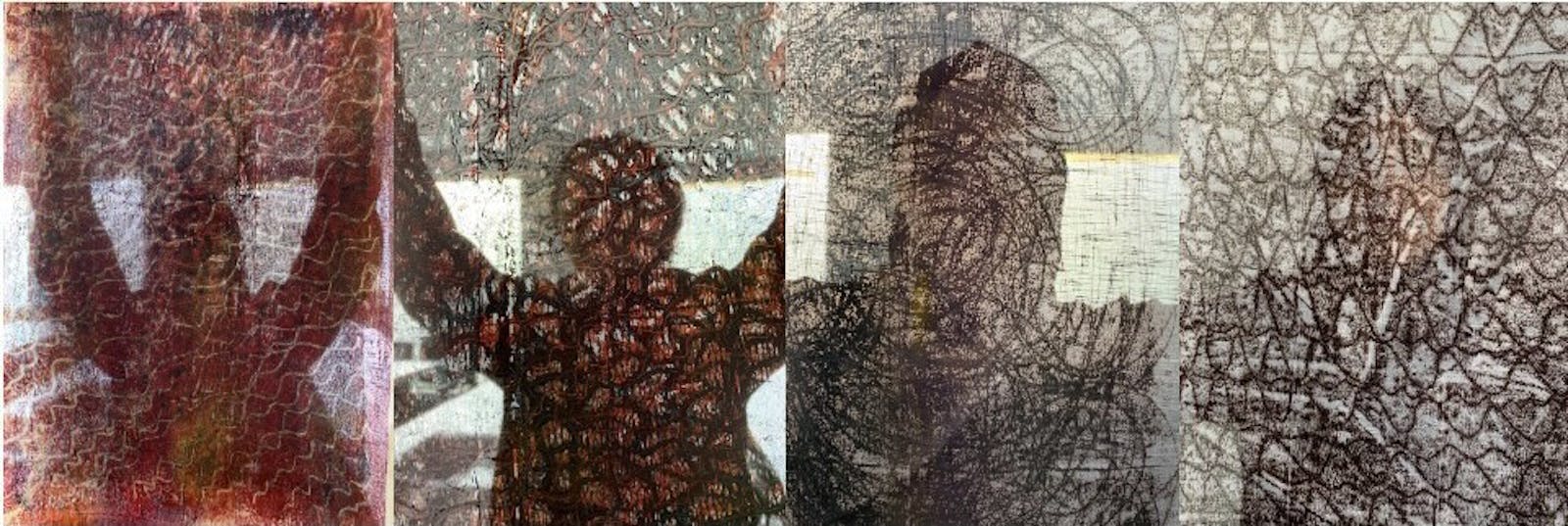
Participants holding up her print “a veil” which almost see through, 2019
Patterns, lines, dark and light colours all help to create shielding. It is not just about layers but also about drawing, and using textures that weave answers together
Now, the layering in my artwork operates on several levels; with pigment, fabric, transparency and colour. Stitching layers of fabric together also creates additional levels of layering where the fabrics overlap, leading to new opacities. During the workshops we talked about the practice of veiling, and we printed simple scaled-up veils into soft, portable and fluid dividers that became different kinds of veils, but that the women felt still protected their sense of privacy. When the women first printed a small piece of fabric, they felt it was less like a veil, but more like a decoration because of its light colours and pattern: they preferred a veil to be dark. They explained how they felt about scaling up a veil from a small piece of fabric that only covered their face, to a divider – a larger piece of fabric held up in front of a woman’s body.
Soft Dividers
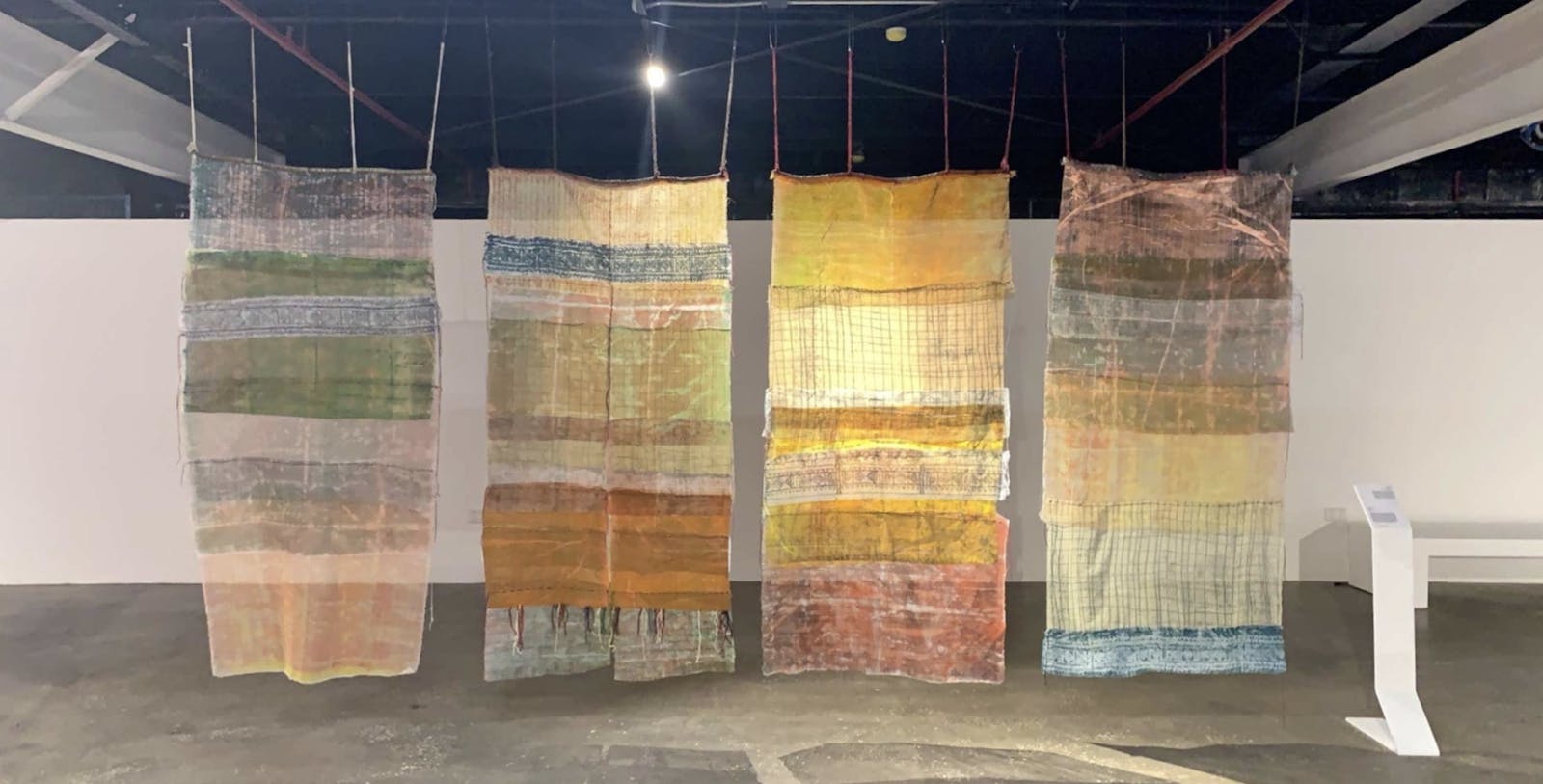
Soft dividers, group exhibition 'From Within' at Ad-Diriyah, Jax 01 in Riyadh, 2019/20

Soft dividers, Showing a gap or an opening between the fabrics enhancing the feeling of cover by contrast of no cover, 2019/20

Soft dividers, showing veiled women pass behind the Soft Dividers, 2019/20
Generally, as I move between cultures, I recognise the same need for privacy in London as I do in Riyadh: my creative practice becomes a way to cope with this, allowing me to maintain an internal comfort zone. I transpose the Al Sadu tent divider into a new form which becomes a soft wall. I bring it into public space, a result of moving between London and Riyadh, so that the veil – the divider – continues to give me, and Muslim women, a sense of privacy, regardless of cultures. When I break the veil down to its basic form, the abaya, which is a full-body cover or the veil extended, it is just a simple piece of fabric, designed, cut, sewn, and wrapped around the body, just like the basic form of any other women's garment. However, the difference between the abaya and most western women’s apparel is that the abaya offers a level of privacy for women in a public space. Although the abaya is a powerful garment, it can skew non-Muslim understanding of a Muslim woman. Wearing the abaya, I may be judged to have no individuality, no real identity, but to embody the impossible composite of a woman as terrorist, backward, uneducated and trapped at home. When I first arrived in London, the city felt naked to me, devoid of privacy with a parade of exposed flesh on offer. Confronted by this, I wondered if I shared this discomfort with other veiled women. I also sensed that the veil is part of forming an identity, and what actually makes the shrouded Muslim woman into someone. She is not invisible behind her veil.
Zones of Privacy
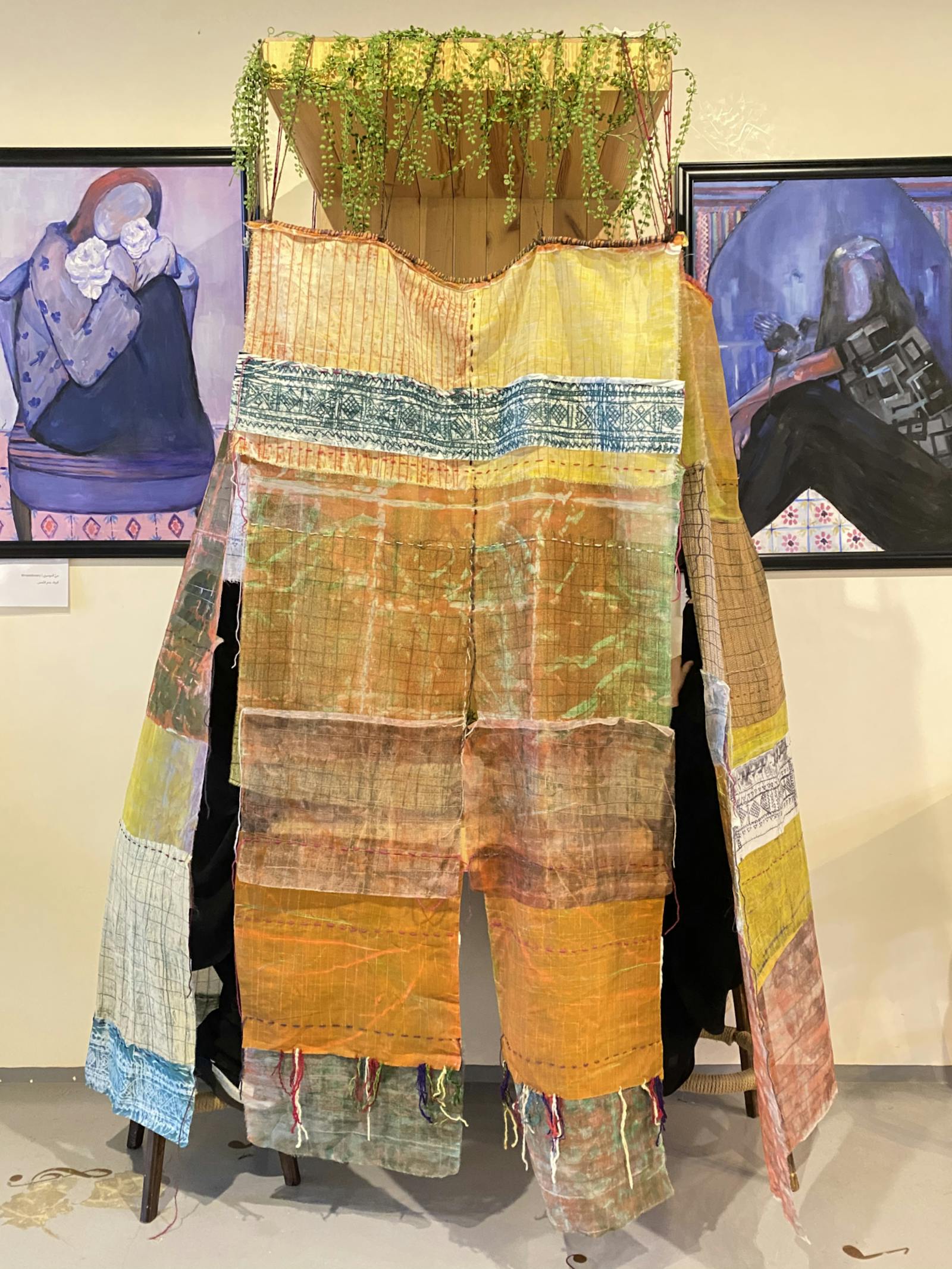
My Soft Dividers at Mafan Café in Riyadh to test Zones of Privacy, 2020
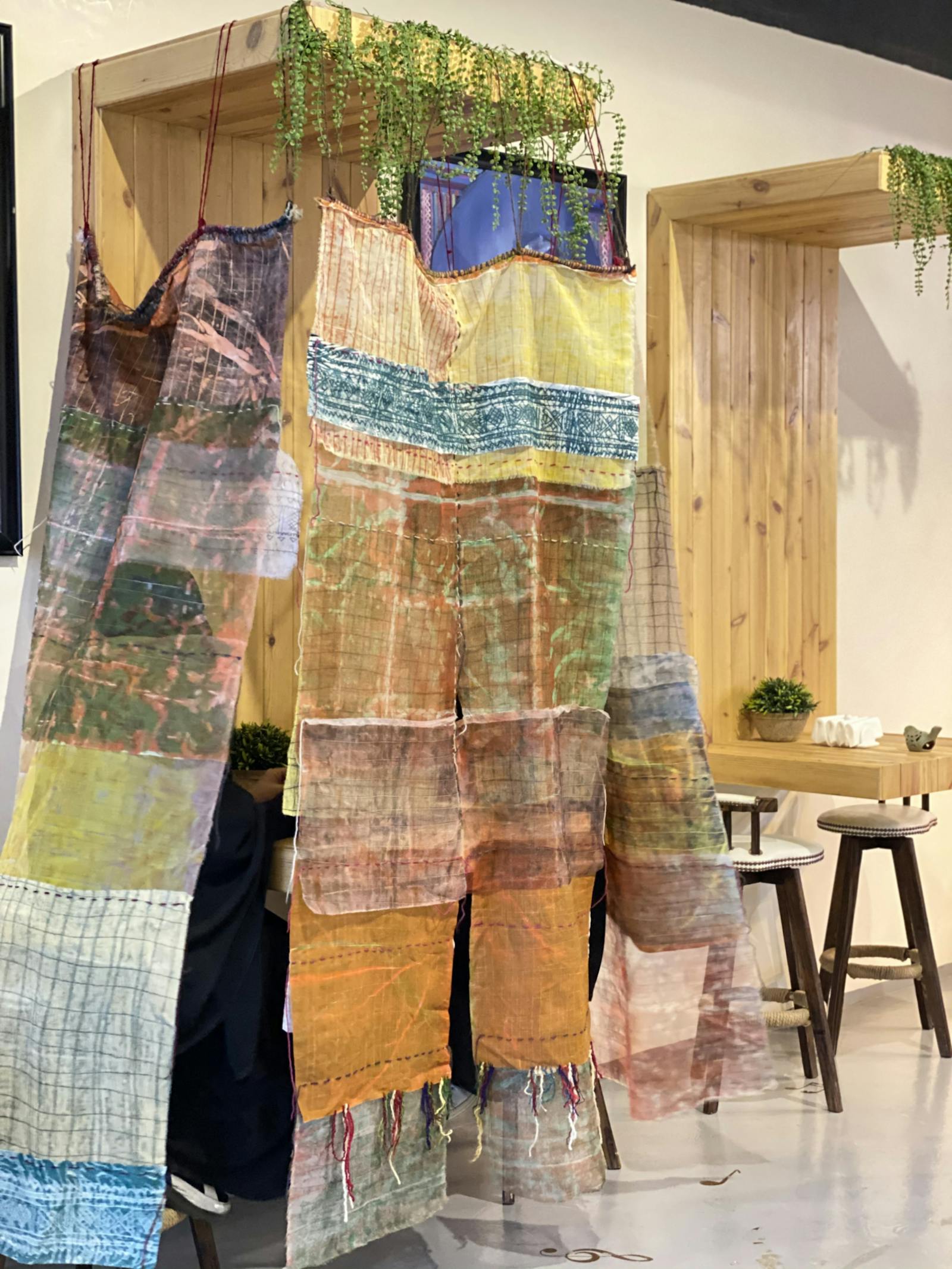
My Soft Dividers at Mafan Café in Riyadh to test Zones of Privacy, 2020
As my research progressed, Soft Dividers became increasingly architectural, incorporating walls as my need for privacy increased during my time living in London and entering public spaces. The cubicle artwork I made uses four dividers to form a soft room with three fluid walls mounted against one solid wall. In the image above, the dividers are not a garment. Nevertheless, the layers of flat fabric arranged in a cubicle mimic a garment-like structure, although the cubicle artwork is not worn but walked into and occupied. Added layers, whatever form they take, construct comfortable levels of shielding.
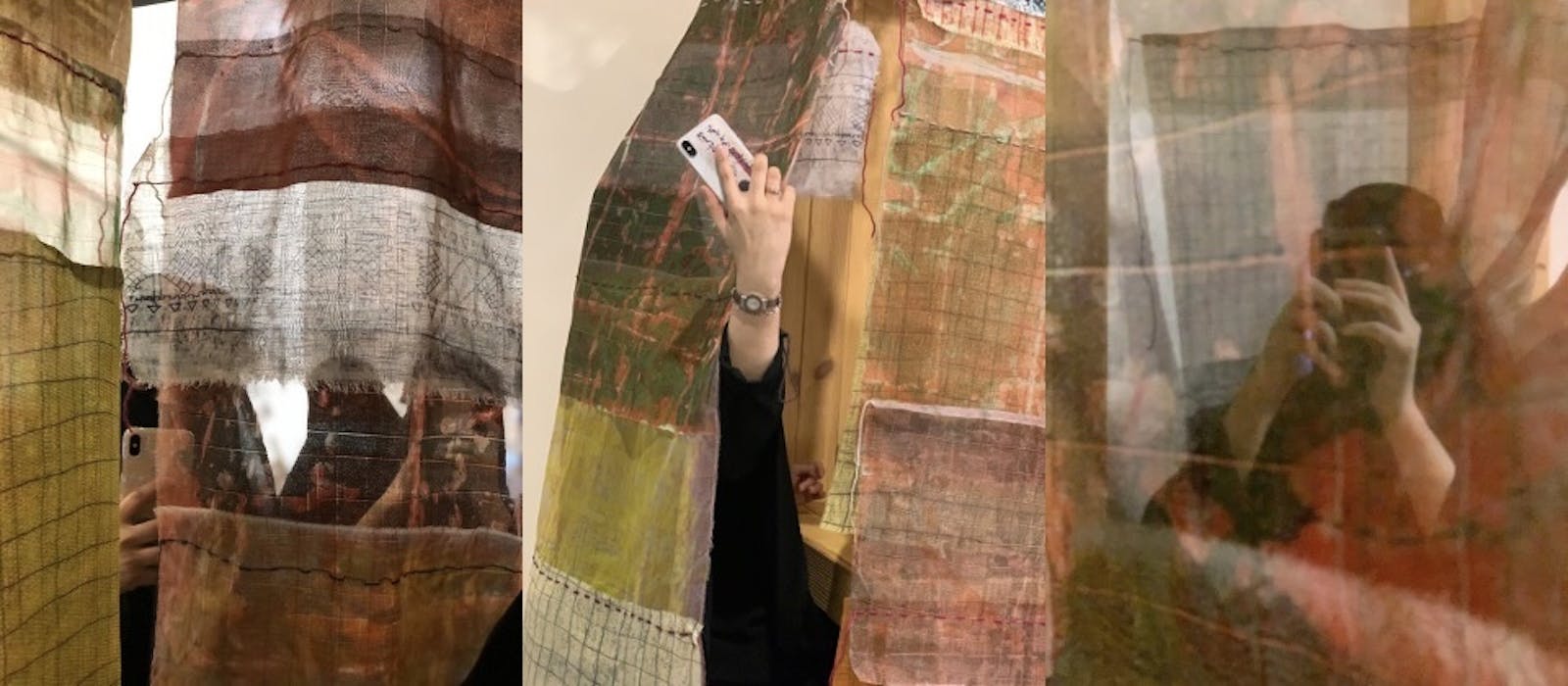
The participants taking a photo in and out my Soft Dividers (selfie, women outside, take a photo of me as I record the video), 2020
During the time of my first documenting their movements into and out of the cubicle the participants did not take or ask if they could take any photos. Only towards the end, did they ask if I minded photographing them. I was surprised by the women’s desire to have any personal photographic record. They too seemed to feel a need to document their experience. As a result of this, documenting the human experience with and within the artwork and the participants being part of the artwork became increasingly important to me. I understood that the development of the artwork itself, and also the exchange between artist and participant or viewer is linked to documentation. As a result of these new understandings, documentation of this project began to incorporate notions of ownership of the experience, in particular ownership around textiles and space, and how the participants see their privacy, in relation to the textile and how textiles represent the materiality of privacy for them to start to own the experience of the object. This was an unexpected addition to my practice. I decided to shift the level as well as position of the concepts of occultation. I became the observer and the women the directors, as well as the creators of the experiences. This is one aspect of PAR, where the participants become collaborators in the artwork. I found that the presence and involvement of the women participants pushed the research forward and changed the direction of the artwork. The women being documented or documenting themselves raises the understanding of the experience and therefore the multi-layered nature of an Arab Muslim sense of privacy.
Veiling the Veil: A Conceptual Exploration

Veiling the Veil, a sequence of still images in which the participant is M-M slowly emerges as she opens and gently closes the soft dividers, 2020

Veiling the Veil, a sequence of still images in which the participant is M-M slowly emerges as she opens and gently closes the soft dividers, 2020
By using layers of print on textiles to create different levels of transparency, and fluid and soft boundaries, I suggest that privacy lies in between the material and the immaterial. Layers and the constant acts of veiling and unveiling also confuse our understanding of who is the observer and who is the participant. As I tested how textile can create layers of privacy, my research developed into an exploration underpinned by a metaphysical notion more conceptual than the previous concrete printed shapes. Veiling the Veil, as I titled this exploration, shows the sequence of movement as a woman emerges from the semi-transparent divider of soft textile. She moves between the additional soft divider layer, her veil-layer and her clothing. The soft divider and the veil are temporal extensions of each other. They perform the same function. Veiling the Veil presents a sequence of still images of the body as it moves in front of and behind the material, so that the full flow of movement can be thoroughly grasped. This slow-motion tracking of movements is one way of documenting my work. It re-enacts how privacy is manifested in the way a body approaches or distances.
